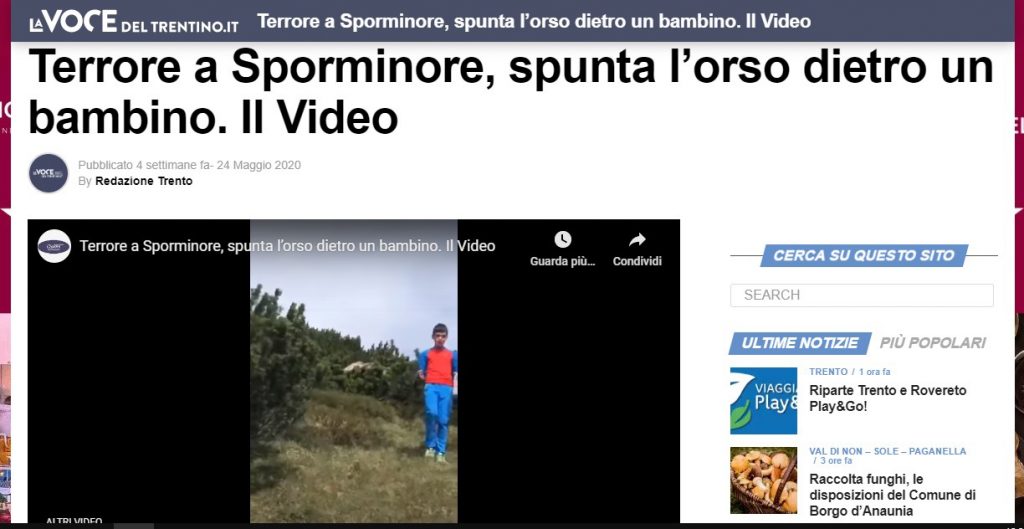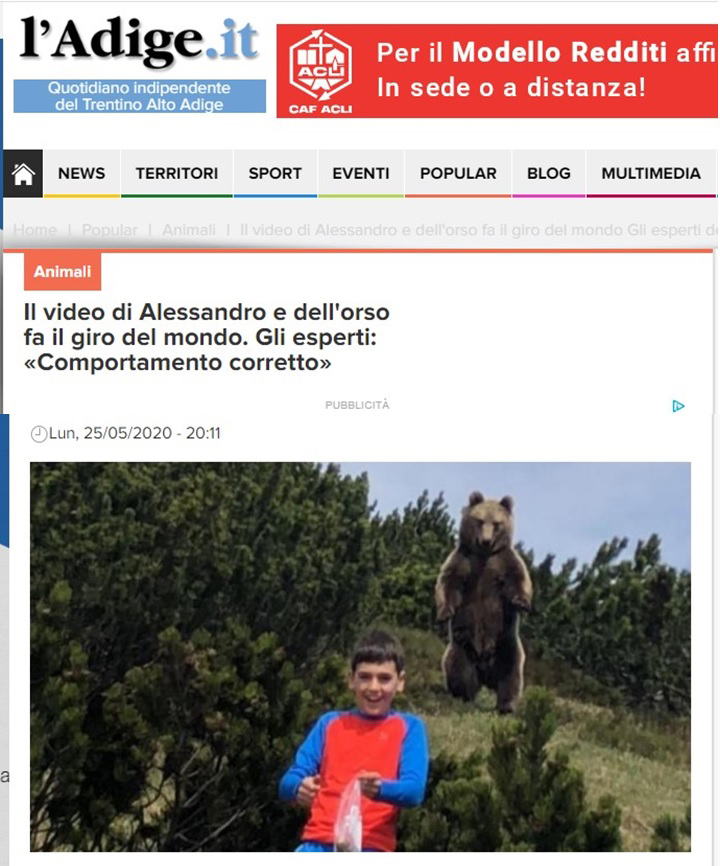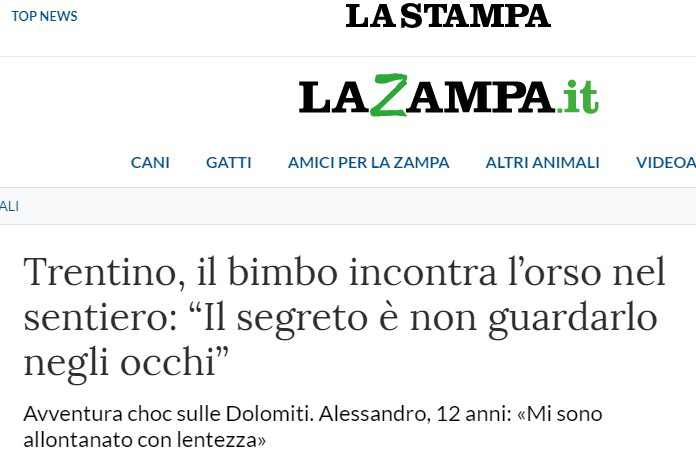It was May 24th the first time a local newspaper reported the video linked below. Alessandro, a boy,12, from Trentino (Italy) met a bear while hiking with his family in Brenta dolomites. They had a very close encounter but he was able to stay cool and to remain calm, acting appropriately for the situation. As you can see from the video, the boy walks calmly down the hill, away from the bear, while the bear follows him only a few meters behind. The bear soon loses interest in the family and walks away.
The video has gone viral and this was good because it’s a very educational video: Alessandro did everything he was supposed to do. He managed to remain calm without running or screaming and he claimed that he did so because he had watched a video outlining what to do when encountering a bear. This underlines once again the importance of a right communication.
“I’m passionate about animals,” Alessandro said. “I believe the bear behaved well.”
I’m going to analyse some headlines of local, national and international newspapers. I just analyse the headlines because they are what everybody reads. Most of us give a look at them and then decide whether to look at the entire article. That’s why the headlines could bequite enough to shape public opinion and that’s why sometimes we find strong words chosen in order to impress the public and to lead their mind to non-objective thoughts. When the topic is a burning issue, no matter if it is a social, political or scientific issue the effort to shape readers opinion may increase.
La voce del Trentino. Local press. “Terror in Sporminore, a bear shows up behind a young boy.

If we don’t read the entire article, we think this was an awful and very dangerous experience, which at the end was not since we can clearly hear Alessandro say “This was cool”. Of course it was a scary and delicate situation that did not need to be underestimated, but the word “Terror” is used to foment rage, fear and discontent about bears in an area where there is still a lot to do about coexistence.
L’Adige. Local press. “The video of Alessandro and the bear goes all around the world. The experts say: “He behaved correctly”

In this case the reader can be encouraged to read more and see if there is some information on what to do when encountering a bear. The video screenshot could anyway give a wrong impression of what’s going on. Bear behaviour is often misinterpreted and I bear standing up on its hind legs is seen as aggressive. This behavior instead allows a bear to get more information on what’s going on from its signs of smell, sight and hearing. It shows curiosity, not aggression.
La Stampa. “The boy meets the bear on a trail. – The secret is not looking into its eyes” National Press.

If you read the entire article you can say it’s a good and balanced article. It describes well what happened and it gives important information on how to behave in a situation like that. On the contrary, if you just read the headline you may think that avoiding eye contact is the key to be safe when encountering a bear. We know it’s a little more complex than that: encountering a bear could be an amazing experience but it’s a serious deal that has to be afforded the way experts suggest to avoid unpleasant situations.
The New York Times. International press. “The boy, the bear and a Close Call in the mountains of Italy.

Of course this article has been read! Who doesn’t want to know about a boy “close call” with a bear? Looking at the headlines I’m prepared to read about a terrifying situation; I could think that the boy is lucky to be alive and therefore I could think that the bear shows aggressive behavior. Of course we know that people like the thrill and the idea that we can all be heroes, but probably we should start writing about how we can coexist with nature instead of what we can do to “win” over it. That’s the big challenge.
We know well that the first function of the mass media is to provide news and information to the masses. We all need information to be conscious of the reality we live in and we put our trust on the media to understand what’s going on, to improve our knowledge and sometimes to grow new ideas, new ways of thinking. However the influence of the media on our society is so big that we should understand how it really works and be aware of some tricks that could confuse or influence our thoughts.
When we want to communicate science we have to be very careful and choose wisely our words and images. We have to be sure that our writing won’t influence any opinion. We want to share scientific information so that our readers can learn and elaborate their own opinion. At the same time, as readers we all have to be responsible people of a society when we face the media and try to avoid the mind tricks we may run into.

